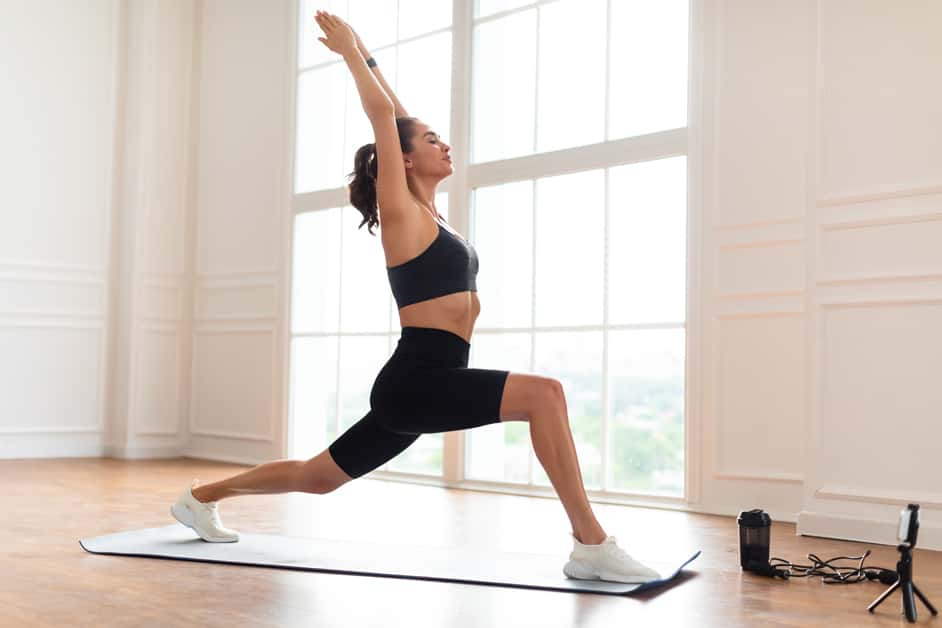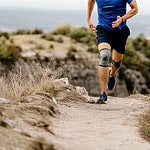Pre-workout
Before starting any workout, it is wise to warm up the body. Especially if one suffers from knee pain. Warm-up for 10-15 minutes. You can do dynamic stretching, foam rolling, and light jogging. This prepares the body for exercise and reduces knee pain.
Stretch and warm up your muscles
Stretching is essential for reducing injury and helping muscle recovery. It’s especially important for those with knee pain. Regular stretching can improve flexibility, posture, and muscle strength – all of which help prevent injury.
To warm up before a work out, start with dynamic stretches – simple, controlled movements (e.g. leg swings, walking lunges). This helps prep the knee joint for more vigorous activity. After your work out, static stretching (e.g. hip flexors, quads, calf muscles) helps fill your knees with oxygen-rich blood.
Research suggests that 10 minutes of light-to-moderate aerobic activity like jogging or walking is good for prepping the body. Listen to your body during these activities, and adjust if you need to. Finally, after exercise, cool down with light stretching or 5 minutes of easy walking. Then, take a rest period or go to bed!
Wear compression clothing
Compression clothing can be a benefit for those with knee pain, no matter the time of day. A snug fit helps support muscles, improving blood circulation and decreasing inflammation. This can lower the chance of injury and help healing. Plus, compressive fabrics wick away sweat to keep your body cool when active.
For optimal performance, choose garments made with breathable materials.
Drink plenty of fluids
Drinking fluids during and after exercise is important to prevent knee pain. Replenish lost fluids if you sweat a lot. Caffeinated drinks and sodas should be avoided as they can disrupt sleep. This impacts knee pain because body can’t repair itself during restful hours.
Choose water or sports drinks with electrolytes instead. They better mimic body fluids and provide minerals and nutrients for healthy muscles and joints. This helps keep knees feeling good after a workout. It’s important to talk to doctor about medications and energy drinks before using them for any medical condition.
During Workout
Workouts with knee aches can be hard. But, it doesn’t need to be that way! Taking the right precautions prior can help with the pain.
Here are some tips for evening exercises, especially for those with knee pain. Remember to:
- Warm up your muscles with light stretching and walking.
- Focus on exercises that target your core muscles like planks and squats.
- Try low-impact exercises like swimming or biking.
- Listen to your body and take breaks when needed.
- Cool down with some light stretching after the workout.
Take breaks to cool down
In the evening, after a workout, your leg muscles can become stiff and sore. Knee pain can make it even worse. To prevent this, take breaks to cool down.
Adjust the rest period based on how tired or sore you are. For tired and somewhat sore muscles, 5 minutes is enough. If more exhausted, 15-20 minutes should do.
When resting, don’t stress the knees. Stretch out your quads, hamstrings, and calves to release lactic acid and help the muscles recover. Foam rolling can also help reduce cramps and joint pain.
If pain or discomfort persists, talk to a doctor to make sure you’re doing the right rehab program.
Monitor your heart rate
Checking your heart rate during and after working out is important for knee pain prevention. If your heart rate remains too high, it can stretch and overuse ligaments in your knee. Use a heart rate monitor or fitness tracker to keep intensity under control.
Take breaks during exercise to lower blood pressure and stress levels. This will help reduce pain while still getting the workout done.
Do cool down exercises like swimming, cycling, and yoga to relax tight muscles and reduce fatigue. These exercises also help reduce swelling around damaged ligaments and help with recovery time. If something doesn’t feel right during or after exercise, stop.
Use a fan or air conditioning
Cooling down after a workout is important for those with knee pain. Ice baths, stretching, and fans or air-conditioning can help reduce heat. Lower humidity at home can be beneficial for those with osteoarthritis.
Air conditioning circulates cooled air in a room. Fans designed for comfort can provide targeted cooling, without drafts or blasts of cold air. This creates the optimal environment for recovery and reduces inflammation.
Post-Workout
Workouts finished? Time to cool down! This helps reduce stress on the body and manage knee pain. A few steps to wind down:
- Stretch your muscles.
- Walk it out.
- Drink some water.
These simple measures can reduce post-workout pain and discomfort.
Take an ice bath or cold shower
An ice bath or cold shower after you work out can help reduce soreness and knee pain. Cool water quickly lowers your body’s temperature. It also soothes an inflamed or swollen knee. Sitting in an ice bath can speed up tissue recovery and flush out lactic acid.
If an ice bath is too much, take a cool shower. But be careful not to take too long, or you could get hypothermia.
Apply an ice pack to the affected area
After physical activity, it’s vital to cool down correctly. An ice pack on the affected area is a great way to reduce inflammation and soreness. Wrap the area with a cloth before applying the ice to avoid frostbite or skin irritation. Keep the ice pack on for no more than 20 minutes, with an hour between applications.
To further reduce swelling, use compression wraps or garments around the knee. Stretching and light activity may help improve circulation, but always stop if you experience pain or discomfort.
Wear compression clothing
Compression clothing can help with post-workout cool down for knee pain sufferers. It fits tightly and reduces muscle vibration during activity. It also quickly removes sweat for cooling and extra protection against chills. Oxygen flow to the muscles is increased, aiding recovery and reducing inflammation.
Buying compression wear made for knee pain is best for cushioning and support around the joints.
Other Tips
Your knees can be feeling tired and sore after an intense workout. To reduce the pain and discomfort, there are some tips. These tips can help with reducing swelling, inflammation and provide relief.
Here are other ideas to cool down your knees post-workout!
Get plenty of rest
Rest is essential for optimal productivity and great health. Not sleeping enough can have a huge effect on you mentally and physically. Quality of sleep matters just as much as quantity. Avoid stimulants such as caffeine, nicotine, and alcohol before bed. Create a calming evening routine- like drinking herbal tea or having a hot bath.
Exercising daily helps to improve the quality and quantity of sleep. Exercise for at least 30 mins daily to reduce stress and relax before bed. Make a consistent wake-up time. Go to bed and wake up at similar times every day. This builds predictability, which helps get a better night’s sleep.
Avoid working out in the heat
If you have knee pain, be extra cautious when exercising. If possible, avoid working out in the heat of the day. Find a cooler area, like a gym with air conditioning, or a shaded outdoor spot.
High intensity workouts put extra strain on your joints and can worsen knee pain, so stick to moderate exercises like low impact aerobics and walking. Take breaks during your workout, and give yourself time to cool down before and after. Plus, don’t forget to stay hydrated to keep your joints and muscles healthy!
Eat anti-inflammatory foods
Eating certain foods can help reduce inflammation in the knees. Omega-3 fatty acids, found in fish and chia seeds, can reduce arthritis-associated pain and inflammation. Other anti-inflammatory foods include ginger, turmeric, papaya, pineapple, and blueberries. Adding these to your diet can give you relief from knee pain during workouts. Make sure you’re getting enough calcium and magnesium for joint health.
More tips for better knee health:
- Get plenty of rest.
- Stretch before exercise.
- Avoid high impact workouts.
- Choose the right shoes.
- Take a break if in pain or discomfort.
- Warm up before your workout.
These will help prevent injury, and could lead to improved performance when you exercise in the evening.
Frequently Asked Questions
Q1: What are some tips to help cool down after an evening workout to reduce knee pain?
A1: When cooling down after a workout, it is important to gradually reduce the intensity of the exercise. This can be done by walking or jogging for a few minutes before stretching the muscles around the knee. Additionally, foam rolling the affected area and using a cold pack can help reduce swelling and decrease pain.
Q2: How long should I cool down for after an evening workout?
A2: Cooling down should last between 10 and 20 minutes and should involve a combination of stretching and light activity. Foam rolling and using a cold pack can also help reduce pain and swelling.
Q3: Are there any other tips that can help reduce knee pain after an evening workout?
A3: It is important to stay hydrated before, during, and after exercise to ensure the muscles are properly lubricated. Additionally, it is important to choose the right shoes for the workout to ensure the knees are supported and any existing knee pain is not exacerbated.





